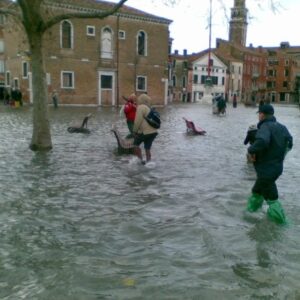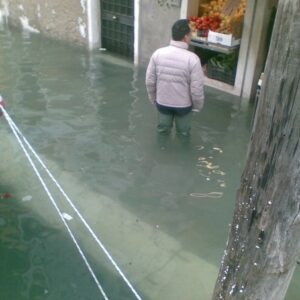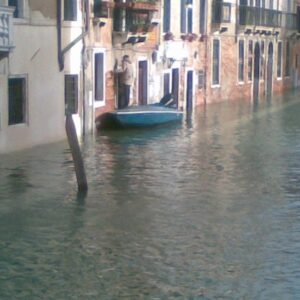The high tide in Venice today was even higher than forecast, reaching a level of 156cm above the historical average. This is the fourth highest level in the last 135 years. In 1966 the tide reached 194cm, 166cm in 1979 and 159cm in 1986.
About two thirds of the city has been under water, with at least 60cm of water on St. Mark’s Square. It should be enough for a good paddle, if only I had been there.
The tide was caused by a combination of several independent factors. The normal astronomical tide was only 56cm, but heavy rain in the area which drains into the lagoon and very strong SE winds in the Adriatic Sea caused the tide to build up to a much higher level than anticipated. A low pression zone on the upper Thyrrenean Sea caused heavy rain on central and northern Italy, which then moved towards the north east. On the Adriatic Sea a strong SE wind blew all night, at about 35-40 km/h, rising to 60-72 km/h in the early morning, and it continued all day.
The effect of the wind is that the tide enters the lagoon slightly higher than the astronomical tide, but the water cannot return to the Adriatic Sea later, causing one high tide to build on top of the previous. Add to this the rain, and the water level just rises and rises.
The first forecasts were for 140cm, which had to be adjusted several times during the day. The municipal tide forecast service has come under some criticism for this ‘error’ but the situation has been quite exceptional and none of the models used were able to forecast this tide correctly.
At the entrace of the lagoon at San Nicolò the tide arrived at 160-170cm at its highest.
At the time of the highest water level the weather in Venice was quite rough.
The population of Venice was alerted throughout the day by voice mail services, SMS services to 10000 subscribers (I have at least 5 or 6 messages on my phone), electronic signs on the motorways, loudspeakers in Piazzale Roma, audible alarms and sirens.
At first, based on the initial forecast, the employees of VESTA (the municipal garbage removal company) put out four kilometres of raised walking platforms used in the lower areas of the city during high tides, but they soon had to remove them again. The rising water level caused the platforms to float on the water, with the risk of people falling in the water. After the tide subsided the same people started cleaning up the city, as garbage had been left all over the place.
The employees of ACTV, the municipal public transport company, had previously declared a strike, but declined in face of the gravity of the situation. A limited number of boats circulated to ensure communication between the various islands and to pick up people stranded on vaporetto stops and elsewhere.
The photos are taken in Venice on December 1st, 2009, by Giuliana Pauletti and Riccardo Sambo.
Links:






























Comments
9 responses to “Exceptional high tide in Venice”
[…] For more about the high water today, check out: Living Venice Blog The Globe & Mail Yahoo News (some great photos of the flooding here) Venice flood pictures […]
High tide? Over here, we call that a flood.
Venice has a special relationship with the sea. The tide is a part of everyday life, though normally it stays in the range of -40cm to +80cm. A tide of +110cm which floods St. Mark’s square happens a couple of times each year.
It is worth noting that the city administration informed the Italian government yesterday, that there was no need to declare a state of emergency, as the normal high tide precautions were able to handle the situation. Nobody’s dead and I haven’t heard of grave incidents. It was mostly discomfort, limitations on movement in the city and quite a bit of material damage, but in the end things are just things.
Today they had forecast +110cm with the the normal systems, I got an SMS on my phone here in Denmark, but it only arrived at +105, which is high but not an emergency.
The raised walking boards they put up at high tide can be used up to +120cm and the vaporetti (water buses) up to +140cm.
Nice post. Thank you for the info. Keep it up.
> Nobody’s dead and I haven’t heard of grave incidents. <
What happens to the historic buildings during such an exceptionally high aqua alta? Does the water hurt their walls or the force of the waves possibly cause a collapse? There are visibly leaning belltowers in Venice and some buildings have walls which are definitely not vertical.
I’ve even heard the higher stories of palaces are sometimes made of mud bricks, especially if it was an later expansion of a medieval casa and the weight of extra stone or red brick floors would be too much burden.
It is really a marvel that Venice is standing after the many centuries, the inhabitants must love the city very much and be faithful to St. Mark!
One more question: what happens to Caffe Florian during such a high tide? I heard the Piazza is the lowest altitude part of Venice, so it gets the aqua alta most often. If 60cm of water flows into the Florian halls, what happens to the beautiful mirrors, paintings and other famous interior decorations? How do they prevent rot? Do they have a special apparatus to dry the place afterwards?
Yet another question: what about MOSE? Will this 20-years-record-high tide event change public opinion about the venetian protective dam system?
In early September I watched the Regata Storica on TV and saw a casa owner hang a giant bedsheet in the window. It said “NO to MOSE” in big red letters and I think it was rude to misuse such an international TV coverage event.
I understand many people hate Berlusconi for his media power and his gigantomania, but a high-tech gift to venice, worth over a billion euros, should not be refused just because of personal dislike! Both MOSE and the Sicilian cable bridge plan sound like sensible spend of the money.
Some of the people who knows the local waters, sea and lagoon, think that the dams make things even worse, as they hinder the waters of a very high tide to flow out again in time before the next high tide. I am really not an expert, so I don’t know, just passing on the information.
As for the Caffè Florian check out this picture: life goes on…
http://www.flickr.com/photos/marcotortato/3076315549/
It has been a month since you’ve posted. You okay?